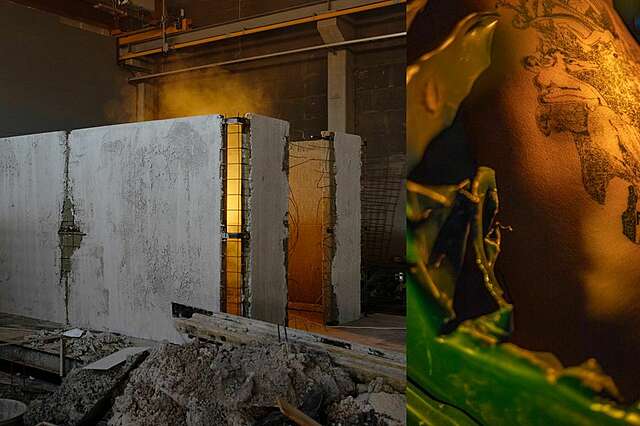The first joint exhibition by the Museum of Finnish Architecture and the Design Museum Helsinki delves into our relationship with gardens

The Exhibition Garden Futures: Designing with Nature Explores the origins and the future of modern gardens. The exhibition will be on display at the Museum of Finnish Architecture and the Design Museum Helsinki from November 10, 2023, to March 31, 2024.
Garden Futures exhibition is a collaboration between the Vitra Design Museum, the Wüstenrot Foundation, and the Nieuwe Instituut, with Helsinki being its first travel destination. Garden Futures is divided into four overarching themes, each offering a unique perspective on gardens. Alongside international examples, themes are also commented upon through selected Finnish cases. As part of the exhibition, the museums will also create a communal Siirtolapuutarha (eng. allotment) space, providing an opportunity to reflect, explore, and gather for events.
The Garden as a Meeting Ground for Dreams and Realities
In many cultures, gardens have been regarded as paradises, safe havens, and reflections of dreams—a microcosm of the world. Gardens reflect how people and societies have related to nature throughout history. For humans, gardens are places where practical work and profound symbolic, philosophical, or even religious meanings coexist.
This theme is illustrated, for instance, by a media installation showcasing works by numerous theorists, architects, and artists from different eras. In these works, the garden is a paradise where hopes and realities converge. Included among them are works by Hans Thoman, Georg Gerster, Athanasius Kircher, Gabriel Guevrekian, Barbara Stauffacher-Solomon, Alvar Aalto, Thomas Church, Vita Sackville-West, and Luis Barragán. A notable Finnish addition is the ceramic artist Birger Kaipiainen. The exhibition features a selection of Kaipiainen’s individually crafted wall plates from the 1960s to the 1980s, in which lush and abundant garden motifs come to life.
The Garden as a Mirror of Society
Gardens have, at different times, reflected societal values, cultural developments, as well as shifts in commerce and politics. The exhibition illustrates how even the most private gardens are intricately connected to society. For instance, it explores how the ideal of self-sufficiency has manifested itself in urban contexts throughout history and how many of the familiar plants in Western gardens have deep roots in colonialism.
The exhibition delves into concepts like Ebenezer Howard’s Garden City (1898), which merged the best aspects of city and countryside. In Finland, self-sufficiency became significant in urban areas, particularly in the early 20th century, with a notable role in wartime community gardens and later in the yards of rintamamiestalot (a rintamamiestalo is a type of detached house built after the Second World War for the families of soldiers who fought in the battlefront). A key figure in the Finnish context was garden designer Elisabeth Koch, who, during her diverse career, designed seven community garden areas and countless small gardens, apartment courtyards, and other urban green spaces. Koch’s legacy is displayed in the form of community gardens in the exhibition.
Gardens as Testing Grounds for New Ideas
What guides our thinking and decisions in garden design? What ideals do we uphold, what do we strive for, and why are gardens so appealing to us? These questions are explored through the stories of eleven pioneering garden creators and case studies, each of them approaching gardening as a laboratory for new ideas.
For example, Brazilian landscape architect Roberto Burle Marx gained international acclaim for emphasizing the importance of native plants in gardens. Dutch designer Piet Oudolf’s gardens epitomize a balance of colours, contrasts, volumes, and flowering times. Jamaican-born writer and gardener Jamaica Kincaid’s garden has, for decades, inspired her contemplation of colonial history, cultural appropriation, and the forced displacement of peoples. In the Finnish context, the exhibition highlights suburban nature, featuring Vantaa’s Pähkinärinne and Espoo’s Soukka, designed by garden architect Maj-Lis Rosenbröijer, as well as suburban courtyards in Itä-Pasila and Espoo’s Matinkylä, created by landscape architect Leena Iisakkila.
The World as a Garden
Under the theme “The World as a Garden”, the exhibition contemplates the future of gardens through current projects. Traditionally, gardens have been seen as refuges where humans have created a tamed version of wild nature. However, the current situation compels us to ask who needs protection and from whom? There are no areas on Earth untouched by human activity or unaffected by it. As the consequences of human actions inevitably transform our environment, the entire planet becomes a garden that we must cultivate, care for, and use responsibly.
Amidst climate change, social injustice, and social isolation, the garden can serve as a space for ideating solutions to these problems. One example of this is Argentinian artist Alexandra Kehayoglou whose work Meadow symbolizes the apparent permanence of familiar landscapes at a time when climate change actually threatens their existence. Kehayoglou’s colossal hand-tufted textile work is meant to be explored with various senses. Exhibition visitors can remove their shoes and step into the artwork, reminiscent of a meadow on the Greek island of Milos.
The foundations for the Design Museum and the Museum of Finnish Architecture will merge into the Foundation for the Finnish Museum of Architecture and Design at the beginning of 2024. Garden Futures, the museums' first joint exhibition, will open to the public in November. Read more about the merging of the museums here.


